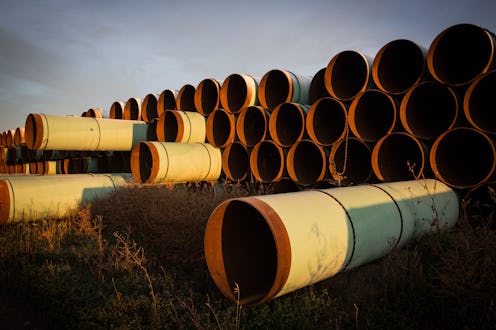News
Keystone XL Proposal's Delay Is A Win (For Now)
Seven years into TransCanada's battle against Keystone XL, environmentalists have won — well, they've won a time out, at least. The Canadian energy company has asked the State Department to suspend its review of the project because they need more time to square out details with Nebraska. The state's environmental concerns have been one of the many roadblocks to the plan's approval.
That might not be the whole story, though. Some environmental advocacy organizations, like the League of Conservation Voters, have argued that the Alberta-based company would rather hold out for a fossil-fuel friendly president in 2017 rather than face the Obama administration, which is likely to reject the plan. Regardless of the reasoning, this is a short-term win for the environment.
The 1,179-mile-long pipeline would run from the tar sands in Canada, through Montana and South Dakota, to Nebraska where it would hook into existing pipelines heading to the Gulf of Mexico-area refineries. It has been championed by the Republican Party as a path to North American energy independence, a source of jobs, and a safer way to transport oil than in train cars. The flip side is of course the environment. For seven years, environmental impact studies have shown the potential degradation the plan could cause. For now, Earth is off the hook. These dire environmental consequences, with the pipeline's approval, are on hold.
Greenhouse Gases
In February, the EPA wrote to the State Department to explain how more greenhouse gases will be released if the pipeline is completed. The State Department had previously concluded the tar sands would be developed whether the pipeline is finished or not. However, the EPA challenged that decision because with low oil prices, sending tar sand oil via ships, trains, or trucks did not make economic sense. In the letter sent to the State Department, EPA assistant administrator for Enforcement and Compliance Assurance Cynthia Giles challenged the idea that trains would be used for oil from new wells if the pipeline is rejected. So with no pipeline, the oil from untapped tar sands stays in the ground and the greenhouse gases stay out of our air.
Water Waste & Pollution
There are two big issues with regards to water. One, the extraction of oil from the tar sands uses a lot of water — up to three barrels of water for every one barrel of oil. Canada limited the amount they could use this year during a dry spell because it uses so much. After the process, the water is very polluted and sits in giant holding ponds near the tar sands. These man-made ponds could leak. Two, the pipeline will cross the Nebraska Sand Hills and one of the largest underground water supplies in the country, the Ogallala Aquifer. If the pipe leaks over this part of Nebraska, the toxic oil mix would quickly soak into the aquifer and contaminate the water supply of a vast portion of the United States, from Texas to South Dakota.
Deforestation
The tar sands are underneath one of the largest natural forests in the world. The boreal forest is home to coniferous trees that run from tundra to the north all the way to temperate forests of deciduous trees to the south. Almost two million acres of forest have been cleared since just 2000. Deforestation in the area topped rates in Russian and Brazil, according to Peter Lee, the executive director of Global Forest Watch Canada.
Native Populations' Health
The normal diet of First Nations peoples, as native populations in Canada are called, has been affected by tar sand pollution. Food staples like muskrats and moose have been affected. Wildlife tested high in heavy metals like mercury, according to a study by University of Manitoba environmental science professor Stéphane McLachlan. There is evidence this can cause cancer. In that same University of Manitoba study, researchers studied First Nations peoples living near tar sand production, and found that more than 20 percent had some type of cancer.
Acid Rain & Asthma
The tar sand production doesn't end in Canada. What travels through the Keystone XL pipeline is not crude oil like what is pumped from a normal well. It's a mix of a solid material called bitumen that has been heated and diluted with other liquids, and it's the bitumen that holds the oil. To convert that into gasoline, diesel, and other usable substances, the bitumen must be refined. The goal of the pipeline would be to bring more of the tar sand oil to Texas, where there are refineries with capacity available. That's bad news for Texas, though, because environmental advocates say the process produces higher levels of toxic sulfur dioxide and nitrous oxide. People living in communities living near the refineries could suffer from more asthma attacks, according to a study funded by the Quebec Ministry of Health and Health Canada. The EPA recently tightened restrictions on refineries to try and limit the effects of the pollution on nearby communities. In 2010, the EPA fined Murphy Oil for releasing too much sulfur dioxide and nitrous oxide, claiming that in addition to causing health problems in people, the substances can cause acid rain.
These terrible consequences are just on hold for now. A firm rejection of the pipeline is the only way to ensure this doesn't happen in 2017.
